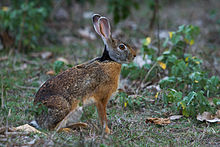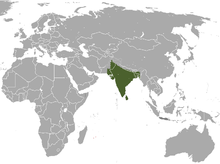Indian hare
| Indian hare | |
|---|---|

| |
| Scientific classification | |
| Domain: | Eukaryota |
| Kingdom: | Animalia |
| Phylum: | Chordata |
| Class: | Mammalia |
| Order: | Lagomorpha |
| Family: | Leporidae |
| Genus: | Lepus |
| Species: | L. nigricollis[1]
|
| Binomial name | |
| Lepus nigricollis[1] F. Cuvier,1823
| |

| |
| Indian hare range (green – native, red – introduced, dark grey – origin uncertain) | |
TheIndian hare(Lepus nigricollis), also known as theblack-naped hare,is a common species ofharenative to theIndian subcontinent,[3]andJava.Its habitat in Java is in rocky highlands.
Description
[edit]The weight of an adult Indian hare can reach 6 kg. Its body length can reach 40 cm. Its hair color is yellowish brown. Indian hares can live 5 to 10 years, and can become pregnant 7 times a year, with an average number of 6 to 12 cubs. Indian hares are relatively more immune to various diseases because they have adapted to a tropical climate, and they reproduce very quickly compared to imported rabbits. Indian hares are relatively small in size and don't have very thick fur.
Introductions
[edit]
It has been introduced toMadagascar,Comoro Islands,Andaman Islands,Western New Guinea,Papua New Guinea,Seychelles,Mayotte,MauritiusandRéunion.[4]
Taxonomy
[edit]There are seven recognized subspecies of Indian hare.
- Lepus nigricollis aryabertensis
- Lepus nigricollis dayanus
- Lepus nigricollis nigricollis
- Lepus nigricollis ruficaudatus
- Lepus nigricollis sadiya
- Lepus nigricollis simcoxi
- Lepus nigricollis singhala
References
[edit]- ^Hoffman, R.S.; Smith, A.T. (2005)."Order Lagomorpha".InWilson, D.E.;Reeder, D.M (eds.).Mammal Species of the World: A Taxonomic and Geographic Reference(3rd ed.). Johns Hopkins University Press. p. 201.ISBN978-0-8018-8221-0.OCLC62265494.
- ^Nameer, P.O. & Smith, A.T. (2019)."Lepus nigricollis".IUCN Red List of Threatened Species.2019:e.T41282A45188041.doi:10.2305/IUCN.UK.2019-1.RLTS.T41282A45188041.en.Retrieved18 February2022.
- ^Suchentrunk, F & Mihajla Davidovic (2004)."Evaluation of the classification of Indian hares (Lepus nigricollis) into the genusIndolagusGureev, 1953 (Leporidae, Lagomorpha) "(PDF).Mammalian Biology.69(1): 46–57.doi:10.1078/1616-5047-115.Archived fromthe original(PDF)on 2016-03-03.Retrieved2006-06-12.
- ^Long, J.L. (2003).Introduced Mammals of the World: Their History, Distribution and Influence.Cambridge: Cabi Publishing.doi:10.1071/9780643090156.ISBN9780851997483.

